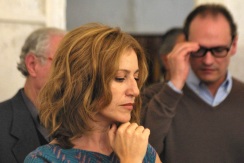|
The Holy Girl
aka La Niña Santa |
| |
 |
Spanish language. Argentina/Italy/Netherlands/Spain, 2004. Rated R. 106 minutes.
Cast:
Mercedes Morán, Carlos Belloso, Maria Alché, Alejandro Urdapilleta, Julieta Zylberberg, Mónica Villa, Marta Lubos, Alejo Mango, Arturo Goetz, Mia Maestro
Writer: Lucrecia Martel
Original Music: Andres Gerszenzon
Cinematography: Félix Monti
Producers: Lita Stantic
Director: Lucrecia Martel
LINKS
|
 he idea behind tantric sex (White Tantra, to be pedantically precise) is that enlightenment can be attained via sustained sexual congress that stops short of the actual climax. Artier-than-thou writer/director Lucrecia Martel attempts to implement a similar paradigm in The Holy Girl , an ascetic Argentine film about a sexual deviant and his possible comeuppance. Avoiding a climactic scene (so to speak) in a movie depicting sexual assault on a minor might seem like a good idea. In Martel's case, however, she denies us the story's entire denouement after boring us to death for an hour and forty-five minutes. That's not attaining enlightenment. That's a perverse joke.
he idea behind tantric sex (White Tantra, to be pedantically precise) is that enlightenment can be attained via sustained sexual congress that stops short of the actual climax. Artier-than-thou writer/director Lucrecia Martel attempts to implement a similar paradigm in The Holy Girl , an ascetic Argentine film about a sexual deviant and his possible comeuppance. Avoiding a climactic scene (so to speak) in a movie depicting sexual assault on a minor might seem like a good idea. In Martel's case, however, she denies us the story's entire denouement after boring us to death for an hour and forty-five minutes. That's not attaining enlightenment. That's a perverse joke.
Meet Dr. Jano (Carlos Belloso), a middle-aged lech—married, of course. As he arrives at a run-down hotel for an medical conference, a woman in a backless dress (Mercedes Morán) attracts his attention. That wouldn't be so bad (he's married, not dead, as the saying goes) except that Jano exhibits an even stronger interest in teenage girls. He indulges his interest by pressing his crotch firmly against teenager Amalia (Maria Alché), in the midst of a crowd enthralled by a theremin player. The poor girl freezes, not knowing what to do, allowing Jano to crush his family jewels on her behind for several long moments. Finally Amalia turns around, catching a quick glimpse of Jano before he slips away.
Unfortunately for Jano (we never learn his given name), Amalia lives at the hotel hosting the medical conference, with her mother Helena (the woman in the backless dress), whose family owns and runs the crumbling establishment. That's Problem Number One. Problem Number Two: Helena mistakes Jano's occasional ogling gaze as repressed passion from a married man. She develops the romanticized notion that they are both heroically resisting an irresistible desire. Problem Number Three: sheltered Amalia is the titular “holy girl.”

Jano (Carlos Belloso) checks out Helena (Mercedes Morán) in The Holy Girl |
A normal modern teenager, upon having a hard package squashed against her rear end, will in most cases immediately turn around and mouth off at the sick bastard, leaving him free to claim he momentarily brushed up against the girl by accident. Amalia is not a normal teenager. She and her best friend Josefina (Julieta Zylberberg) spend their days having their heads stuffed full of religious fanaticism by the parish schoolteacher. “The important thing is to always be alert for God's call,” they are told. Nothing else matters. Amalia's reaction to discovering Jano in the hotel's swimming pool is to pray obsessively. In point of fact, her reaction to most things is to pray obsessively. Amalia decides her calling is to save Jano from sin. How she is to accomplish this salvation remains unclear, but it seems to involve stalking him quite persistently. Meanwhile Josefina discovers her sexuality in more conventional ways.
Amalia's father is absent of course, which may help explain her fascination with Jano. Her primary male influence is her mother's brother Freddy (Alejandro Urdapilleta), who doesn't seem like much of one, and who has no precise role in the film. There's a bizarre scene in which Freddy and Helena call two people in Chile and hang up on both of them. Can't tell you why. Something got lost in the subtitles. And what of Martel's interest in the theremin? This odd instrument, which gives off vibrations that the player modulates by moving his hands above it without actually touching it, is undoubtedly a symbol of some sort, but I don't know what it is.
There is a story here that wants to be told, but never flowers. Martel is determined to make an impressionistic movie out of a collection of miniscule moments, fragmented sounds, and fleeting images—so miniscule, fragmented, and fleeting that they never cohere. The languid, dreamlike sequences in and around the hotel's swimming pool stand out artistically, but Martel remains so obsessed with keeping things small that she ends up leaving out too much. Nothing ever seems to happen. The Holy Girl is unrelentingly, unremittingly, and unapologetically boring.
With the tagline "The Temptation of Good—And the Evil It Causes" Martel appears to want to argue that Catholic fervor wreaks havoc with sexuality, particularly the sexuality of young women, but that's an argument that absolves Jano of responsibility for his own downfall. Certainly, Jano earns a measure of uncomfortable sympathy. He is less a monster than a twisted, weak, confused little man. Perhaps many men think Jano's thoughts from time to time. But there's a line, and if you're mashing your woody against the butt cheeks of a girl thirty years your junior, in a crowd, without her consent, you've crossed it. If Catholic fanaticism can defeat that kind of behavior, then maybe Catholic fanaticism has its good points. I doubt that's the enlightened insight Martel was going for, however.
Review © May 2005 by AboutFilm.Com and the author.
Images © 2005 Fine Line Features. All Rights Reserved.


